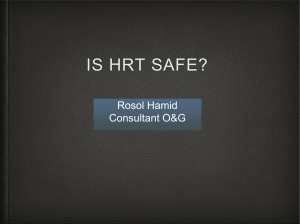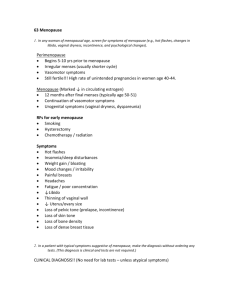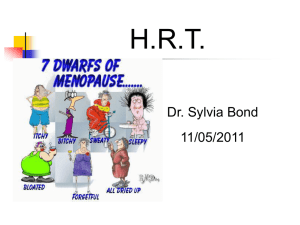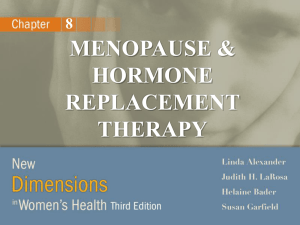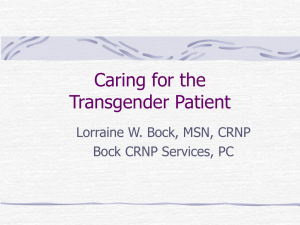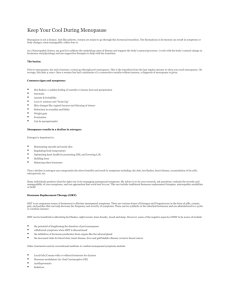1st_ims_global_summit_summary_slide_set
advertisement
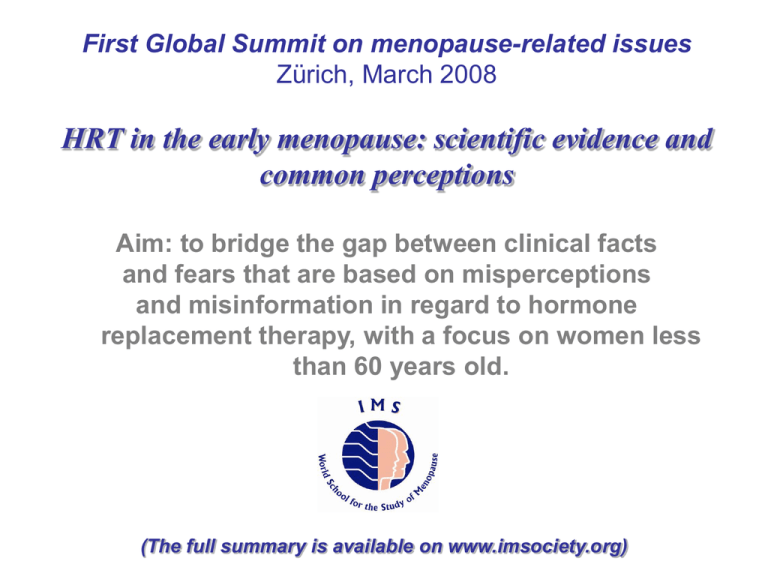
First Global Summit on menopause-related issues Zürich, March 2008 HRT in the early menopause: scientific evidence and common perceptions Aim: to bridge the gap between clinical facts and fears that are based on misperceptions and misinformation in regard to hormone replacement therapy, with a focus on women less than 60 years old. (The full summary is available on www.imsociety.org) Evidence vs. perception Both physicians and the lay public do not address postmenopausal hormone therapy as an ordinary medication. There is a tendency to ‘judge’ hormone therapy by other standards (for example, feminism and sexism are erroneously linked to the debate). While the benefits of hormone therapy are very subjective (vasomotor symptoms) or preventive in nature (fractures), the potential risks involve serious, frightening diseases (breast cancer, stroke). It seems difficult for most people to put on the same scale and to weigh objectively these benefits and risks. Perception-wise, in the post-WHI era, risks are overvalued and generalized to the whole postmenopausal population and to all forms of hormone therapy. Evidence vs. perception Vast amounts of information exist. People tend to be selective and pick pieces of it according to their beliefs and personal experience; thus an overall perspective may be missing. Quality of life Achieving good quality of life is a prime target in menopause medicine, which is as important as prevention and treatment of diseases. There is no argument that HRT is the first choice and the best modality to improve quality of life and sexuality in symptomatic postmenopausal women. Cardiovascular system (1) Perception HRT increases the risk of coronary heart disease (CHD) throughout the whole postmenopausal period. Evidence HRT in women aged 50–59 years does not increase CHD risk in healthy women and may even decrease the risk in this age group. [A] Rossouw J. JAMA 2007;297:1465 Cardiovascular system (2) Perception HRT causes an increase in coronary events in the first 1–2 years in all women. Evidence Early harm (more coronary events during the first 2 years of HRT) was not observed in the early postmenopausal period. The number of CHD events decreased with duration of HRT in both WHI clinical trials. [A] Lobo R. Arch Intern Med 2004;164:482 Cardiovascular system (3) Perception Stroke risk is substantially increased in women receiving HRT. Evidence It is unclear at present whether there is a statistical increase in ischemic stroke with standard HRT in healthy women aged 50– 59. The WHI data showed no statistically significant increase in risk; nevertheless, even if statistically increased, as found in the Nurses’ Health Study, the low prevalence of this occurrence in this age group makes the attributable risk extremely small. [A,B] Hendrix SL. Circulation 2006;113:2425 Grodstein F. Arch Intern Med 2008;168:861 Cardiovascular system (4) Perception The risk of venous thromboembolism is increased during HRT. Evidence The risk of venous thrombosis in the early menopause is approximately two-fold higher with standard doses of oral HRT, but is a rare event in that the background prevalence is extremely low in a healthy woman under 60 years of age. [A] The risk of venous thrombosis is possibly less with transdermal, compared with oral estrogen therapy. [B] Cushman M. JAMA 2004;292:1573 Canonico M. Circulation 2007;115:840 Breast (1) Perception All types of HRT cause an increased risk of breast cancer within a short duration of use. Evidence After 5 years’ use of combined estrogen and progestogen, the WHI cohort showed a small increase in risk of breast cancer of about eight extra cases per 10,000 women per year. Risk was not increased in first-time hormone users. [A] Chlebowski RT. JAMA 2003;289:3243 Stefanic ML. JAMA 2006;295:1647 Breast (1) cont. Perception All types of HRT cause an increased risk of breast cancer within a short duration of use. Evidence In the WHI estrogen-only arm, there was no increase in breast cancer risk for up to 7 years. However, the risk of invasive breast cancer was significantly lower in first-time users of estrogen. [A] In observational studies, a small increase in risk during estrogen-alone therapy was recorded only after long-term use. [B] Anderson GL. JAMA 2004;291:1701; Stefanic ML. JAMA 2006;295:1647 Chen WY. Arch Intern Med 2006;166:1027 Breast (2) Perception The reported decline in breast cancer rates in the US following the publication of the WHI data proves that HRT causes cancer. Evidence A decline in the incidence of breast cancer in the USA started before the WHI publication and can be partially related to fluctuation in screening. There has been no decline in breast cancer registration in the UK following the Million Women Study report, nor in Norway, Canada, the Netherlands and countries with stable screening programs. [B] Li CI. Cancer Epidemiol Biomarkers Prev 2007;16:2773 Kliewer EV. NEJM 2007;357:509; Zahl PH. NEJM 2007;357:510 Breast (3) Perception HRT causes an increase in mammographic breast density. Increase in mammographic breast density is associated with an increased risk of breast cancer. Evidence Increased baseline breast density is a risk factor for breast cancer. Boyd NF. Lancet Oncol 2005;6:798 (review) Combined E + P therapy may cause increased breast density in up to 50% of postmenopausal women, dependent on the regimen (dosage, type of progestogen. The average increase in breast density with standard dose is up to 10%). The effect of estrogen alone is smaller. [A] Greendale GA. Ann Intern Med 1999;130:232 There are no data to support a direct association between HRT-induced breast density changes and the risk of developing breast cancer. Bone (1) Perception HRT should not be used for bone protection because of its unfavorable safety profile. Official recommendations by health authorities (EMEA, FDA) limit the use of HRT to a second-line alternative. HRT could only be considered when other medications failed, were contraindicated or not tolerated, or in the very symptomatic woman. Evidence For the age group 50–59, HRT is safe and cost-effective. Overall, HRT is effective in the prevention of all osteoporosis-related fractures, even in patients at low risk of fracture. [A] Rossouw J. JAMA 2007:297:1465; Cauley JA. JAMA 2003;290:1729 Jackson RD. J Bone Min Res 2006;21:817 Bone (2) Perception HRT is not as effective in reducing fracture risk as other products (bisphosphonates, etc.). Evidence Although no head-to-head studies have compared HRT to bisphosphonates in terms of fracture reduction, there is no evidence to suggest that bisphosphonates or any other antiresorptive therapy are superior to HRT. Cognition (1) Perception Menopause transition is associated with cognitive decline. Evidence There is no evidence of substantial cognitive decline across the menopausal transition. [A] However, many women experience cognitive difficulties in association with vasomotor symptoms, sleep disturbances and mood changes. [B] Meyer PM. Neurology 2003;61:801; Maki PM. Menopause 2008 (in press) Woods NF. J Womens Health 2007;16:667 Cognition (2) Perception HRT increases the risk of cognitive/memory impairment and dementia at any age. Evidence No cognitive benefit was found among women initiating HRT late in the postmenopausal period (after age 65). [A] Observational studies show a decreased risk of Alzheimer’s disease in hormone users and typically involve women who initiated estrogen therapy early in the menopausal transition. [B] Cognitive benefits from estrogen therapy appear to depend on age at initiation. [B] Espeland MA. JAMA 2004;291:2959; Tang M-X. Lancet 1996;348:429 Bager YZ. Menopause 2005;12:12 Cognition (3) Perception Progestogens counteract estrogen effects in the brain. Evidence Limited data exist on the effect of progestogen added to estrogen in the early postmenopause period. Conclusions Menopause symptoms and the incidence of illnesses associated with menopause or HRT may vary to a large extent in different parts of the world, as well as priorities in medical care. In addition, cultural and social attitudes may have a substantial impact, all affecting perceptions and decision-making in regard to menopause management and the use of hormones. Each regional/national menopause society should adapt the general framework according to its local situation and needs. Actions to be taken The forum agreed that education and dissemination of the clinical data are crucial in the process of closing the gap between the scientific evidence on HRT and its perception. Three main targets were identified: the health-care providers, the consumers and the journalists. The message to be delivered should be simple and clear, stressing the benefits of HRT and relieving fears according to the best-quality clinical evidence. The most frequent misperceptions should therefore be identified and balanced by the corresponding data that have been published in the medical literature. Take-home message Many people read only headlines or short messages. For these people, a short take-home message is the following: • The target population for initiation of HRT is usually women up to age 55. • HRT initiated in the early postmenopausal period in healthy women is safe. • Like all medicines, HRT needs to be used appropriately, but it is essential that women in early menopause who are suffering menopausal symptoms should have the option of using HRT.
